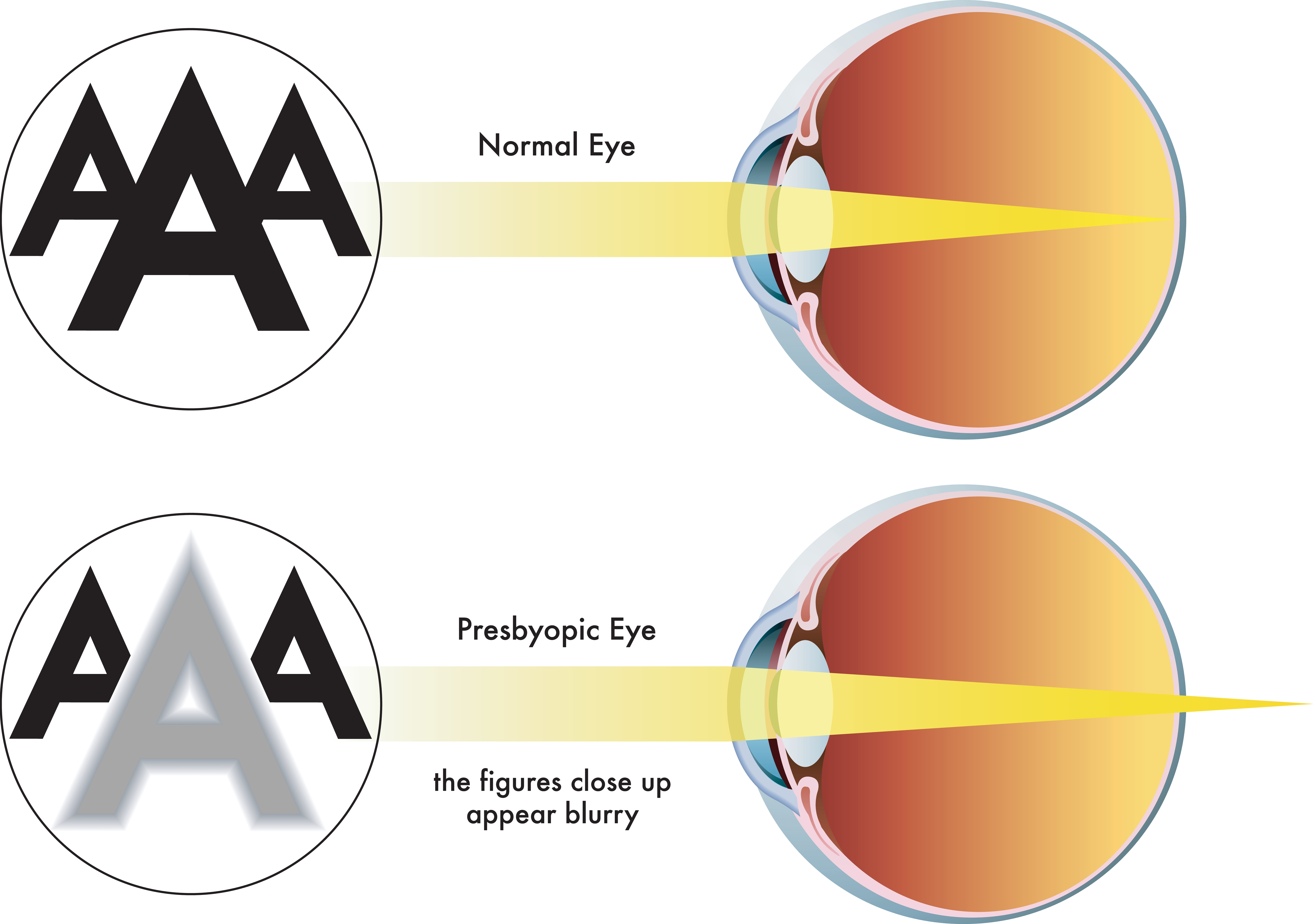Is it Presbyopia or Cataracts?
August 18, 2023
Once you turn 40, did you know your risk of developing certain eye conditions increases? You may be more familiar with age-related eye conditions like glaucoma or age-related macular degeneration.
But the two most common eye conditions in adults over 40 are presbyopia and cataracts. Most people will eventually develop presbyopia, and nearly half of all adults will develop cataracts by age 75.
These two eye conditions are extremely common, and the good news is that they are also quite treatable. However, it can be hard to distinguish the symptoms of one from the other.
Keep reading to learn more about these eye conditions and if it could be presbyopia or cataracts affecting your vision!
What is Presbyopia?

Presbyopia occurs when your eye's natural lens becomes less flexible as you age. With age, the muscles weaken, and parts of the body lose elasticity.
The same is also true with the eye's natural lens. But how does an inflexible lens affect your vision?
You use your lens to focus. It changes shape to magnify up-close objects. But if the lens loses its flexibility and becomes less flexible, it can no longer change its shape the same way, making it more challenging to focus up close.
If you can no longer focus up close on things, like while reading a book or texting on your phone, one of the best ways to remedy this is using reading glasses.
What are Cataracts?
Like presbyopia, cataracts also affect the eye's natural lens. They occur when the lens, which should be clear, becomes cloudy, making it harder to see through.
Like presbyopia, cataracts are associated with aging. They can take many years to develop, and you may not realize you have them initially.
However, your chances of developing cataracts also increase as you get older. Another thing that can make cataracts confusing is their symptoms may overlap with presbyopia.
Some patients may mistake cataracts for presbyopia and vice versa. But both eye conditions are distinct, even if you have them both.
Can You Have Both?
 Yes, you can have both presbyopia and cataracts at the same time. It's quite common to have both eye conditions.
Yes, you can have both presbyopia and cataracts at the same time. It's quite common to have both eye conditions.
Most cataract patients also have presbyopia, as both conditions are typical in adults over 40. You're more likely to develop these eye conditions as you get older.
Unfortunately, the fact the conditions are often concurrent can make the symptoms hard to distinguish. However, you can tell them apart if you know what to look for.
Telling Symptoms of Presbyopia and Cataracts Apart
The primary symptom of presbyopia is being unable to see things up close. It's much harder to see up close when you have presbyopia. Cataracts, on the other hand, have many symptoms, including:

- Blurry vision
- Poor night vision
- Light sensitivity
- Glare and halos
- Decreased color contrast
- Noticing colors look muddy
- Increased injuries due to worsening vision
- Needing more frequent prescription changes to your glasses and contact lenses
These symptoms often progress and appear very slowly. Blurry vision and poor night vision are often mistaken for presbyopia.
But the primary difference is that you can see better with more light when you have cataracts. You may still find it challenging to see up close when you have cataracts, but if you find it's easier to complete fine focus tasks like reading when you have direct light, that may indicate that you have cataracts.
However, the only way to confirm if you have cataracts or presbyopia is to see your eye doctor. Seeing your eye doctor regularly for eye exams after turning 40 will ensure that you can receive an early diagnosis.
They will monitor these conditions if you have them and determine the best course of action, including treatment.
Treating Presbyopia
Traditionally, the best way to treat presbyopia has been with reading glasses. Reading glasses have different strengths and can help you see better up close.
However, they can be inconvenient, as they aren't something you can always wear. Wearing them affects your distance vision, making it very hard to see at any distance besides up close.
When you have your reading glasses on, you have to keep them on hand for when you need to do close-focus tasks like reading. But if you're tired of the back and forth associated with reading glasses, there's another, better treatment for presbyopia called refractive lens exchange (RLE).
Refractive lens exchange removes your eye's natural lens and replaces it with an artificial lens called an intraocular lens (IOL). IOLs come in different varieties, including premium lenses.
Premium lenses can help you see very clearly at many different distances. If you have cataracts and presbyopia, you can treat both simultaneously during cataract surgery. You may also be able to have refractive lens exchange if you have early cataracts that are causing few if any, symptoms or changes to your vision.
Cataract Surgery
 Cataract surgery and refractive lens exchange are almost identical procedures. The most significant difference is that cataract surgery removes the natural lens to vacate the cataract formed on it. In contrast, refractive lens exchange removes the natural lens, which doesn't usually have a cataract.
Cataract surgery and refractive lens exchange are almost identical procedures. The most significant difference is that cataract surgery removes the natural lens to vacate the cataract formed on it. In contrast, refractive lens exchange removes the natural lens, which doesn't usually have a cataract.
However, both procedures include using an IOL to replace the natural lens. Many IOLs can treat presbyopia along with any other existing refractive error.
Health insurance usually covers cataract surgery as it's a medically necessary procedure. Refractive lens exchange, on the other hand, is a vision correction procedure, meaning it's not covered by insurance.
With either procedure, you can opt for a premium IOL. Premium IOLs cost extra, meaning you'll have to pay for them out of pocket. But most patients that choose them are okay with this because they provide much better vision than the standard monofocal option.
Maryland Eye Associates offers several premium IOL options, including multifocal and trifocal lenses. We also have toric lenses, which can correct astigmatism.
Do you have cataracts or presbyopia? Find out if a procedure like refractive lens exchange or cataract surgery could be right for you by requesting an appointment at Maryland Eye Associates in Prince Frederick, MD, now! Isn't it time to take control of your vision?



